Chunfeng Yuan
BOASF: A Unified Framework for Speeding up Automatic Machine Learning via Adaptive Successive Filtering
Jul 28, 2025Abstract:Machine learning has been making great success in many application areas. However, for the non-expert practitioners, it is always very challenging to address a machine learning task successfully and efficiently. Finding the optimal machine learning model or the hyperparameter combination set from a large number of possible alternatives usually requires considerable expert knowledge and experience. To tackle this problem, we propose a combined Bayesian Optimization and Adaptive Successive Filtering algorithm (BOASF) under a unified multi-armed bandit framework to automate the model selection or the hyperparameter optimization. Specifically, BOASF consists of multiple evaluation rounds in each of which we select promising configurations for each arm using the Bayesian optimization. Then, ASF can early discard the poor-performed arms adaptively using a Gaussian UCB-based probabilistic model. Furthermore, a Softmax model is employed to adaptively allocate available resources for each promising arm that advances to the next round. The arm with a higher probability of advancing will be allocated more resources. Experimental results show that BOASF is effective for speeding up the model selection and hyperparameter optimization processes while achieving robust and better prediction performance than the existing state-of-the-art automatic machine learning methods. Moreover, BOASF achieves better anytime performance under various time budgets.
DetailFusion: A Dual-branch Framework with Detail Enhancement for Composed Image Retrieval
May 23, 2025Abstract:Composed Image Retrieval (CIR) aims to retrieve target images from a gallery based on a reference image and modification text as a combined query. Recent approaches focus on balancing global information from two modalities and encode the query into a unified feature for retrieval. However, due to insufficient attention to fine-grained details, these coarse fusion methods often struggle with handling subtle visual alterations or intricate textual instructions. In this work, we propose DetailFusion, a novel dual-branch framework that effectively coordinates information across global and detailed granularities, thereby enabling detail-enhanced CIR. Our approach leverages atomic detail variation priors derived from an image editing dataset, supplemented by a detail-oriented optimization strategy to develop a Detail-oriented Inference Branch. Furthermore, we design an Adaptive Feature Compositor that dynamically fuses global and detailed features based on fine-grained information of each unique multimodal query. Extensive experiments and ablation analyses not only demonstrate that our method achieves state-of-the-art performance on both CIRR and FashionIQ datasets but also validate the effectiveness and cross-domain adaptability of detail enhancement for CIR.
PC-Agent: A Hierarchical Multi-Agent Collaboration Framework for Complex Task Automation on PC
Feb 21, 2025Abstract:In the field of MLLM-based GUI agents, compared to smartphones, the PC scenario not only features a more complex interactive environment, but also involves more intricate intra- and inter-app workflows. To address these issues, we propose a hierarchical agent framework named PC-Agent. Specifically, from the perception perspective, we devise an Active Perception Module (APM) to overcome the inadequate abilities of current MLLMs in perceiving screenshot content. From the decision-making perspective, to handle complex user instructions and interdependent subtasks more effectively, we propose a hierarchical multi-agent collaboration architecture that decomposes decision-making processes into Instruction-Subtask-Action levels. Within this architecture, three agents (i.e., Manager, Progress and Decision) are set up for instruction decomposition, progress tracking and step-by-step decision-making respectively. Additionally, a Reflection agent is adopted to enable timely bottom-up error feedback and adjustment. We also introduce a new benchmark PC-Eval with 25 real-world complex instructions. Empirical results on PC-Eval show that our PC-Agent achieves a 32% absolute improvement of task success rate over previous state-of-the-art methods. The code is available at https://github.com/X-PLUG/MobileAgent/tree/main/PC-Agent.
SA-GNAS: Seed Architecture Expansion for Efficient Large-scale Graph Neural Architecture Search
Dec 03, 2024


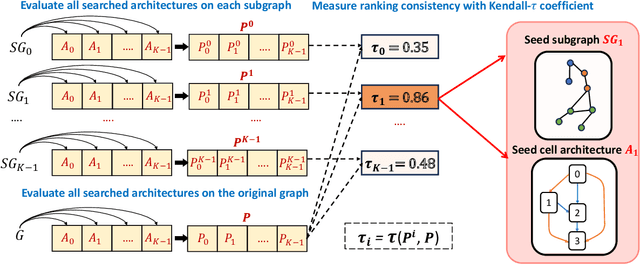
Abstract:GNAS (Graph Neural Architecture Search) has demonstrated great effectiveness in automatically designing the optimal graph neural architectures for multiple downstream tasks, such as node classification and link prediction. However, most existing GNAS methods cannot efficiently handle large-scale graphs containing more than million-scale nodes and edges due to the expensive computational and memory overhead. To scale GNAS on large graphs while achieving better performance, we propose SA-GNAS, a novel framework based on seed architecture expansion for efficient large-scale GNAS. Similar to the cell expansion in biotechnology, we first construct a seed architecture and then expand the seed architecture iteratively. Specifically, we first propose a performance ranking consistency-based seed architecture selection method, which selects the architecture searched on the subgraph that best matches the original large-scale graph. Then, we propose an entropy minimization-based seed architecture expansion method to further improve the performance of the seed architecture. Extensive experimental results on five large-scale graphs demonstrate that the proposed SA-GNAS outperforms human-designed state-of-the-art GNN architectures and existing graph NAS methods. Moreover, SA-GNAS can significantly reduce the search time, showing better search efficiency. For the largest graph with billion edges, SA-GNAS can achieve 2.8 times speedup compared to the SOTA large-scale GNAS method GAUSS. Additionally, since SA-GNAS is inherently parallelized, the search efficiency can be further improved with more GPUs. SA-GNAS is available at https://github.com/PasaLab/SAGNAS.
mR$^2$AG: Multimodal Retrieval-Reflection-Augmented Generation for Knowledge-Based VQA
Nov 22, 2024



Abstract:Advanced Multimodal Large Language Models (MLLMs) struggle with recent Knowledge-based VQA tasks, such as INFOSEEK and Encyclopedic-VQA, due to their limited and frozen knowledge scope, often leading to ambiguous and inaccurate responses. Thus, multimodal Retrieval-Augmented Generation (mRAG) is naturally introduced to provide MLLMs with comprehensive and up-to-date knowledge, effectively expanding the knowledge scope. However, current mRAG methods have inherent drawbacks, including: 1) Performing retrieval even when external knowledge is not needed. 2) Lacking of identification of evidence that supports the query. 3) Increasing model complexity due to additional information filtering modules or rules. To address these shortcomings, we propose a novel generalized framework called \textbf{m}ultimodal \textbf{R}etrieval-\textbf{R}eflection-\textbf{A}ugmented \textbf{G}eneration (mR$^2$AG), which achieves adaptive retrieval and useful information localization to enable answers through two easy-to-implement reflection operations, preventing high model complexity. In mR$^2$AG, Retrieval-Reflection is designed to distinguish different user queries and avoids redundant retrieval calls, and Relevance-Reflection is introduced to guide the MLLM in locating beneficial evidence of the retrieved content and generating answers accordingly. In addition, mR$^2$AG can be integrated into any well-trained MLLM with efficient fine-tuning on the proposed mR$^2$AG Instruction-Tuning dataset (mR$^2$AG-IT). mR$^2$AG significantly outperforms state-of-the-art MLLMs (e.g., GPT-4v/o) and RAG-based MLLMs on INFOSEEK and Encyclopedic-VQA, while maintaining the exceptional capabilities of base MLLMs across a wide range of Visual-dependent tasks.
SEAGULL: No-reference Image Quality Assessment for Regions of Interest via Vision-Language Instruction Tuning
Nov 15, 2024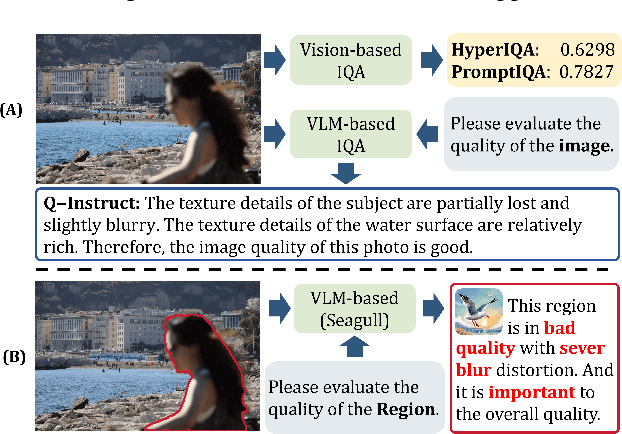



Abstract:Existing Image Quality Assessment (IQA) methods achieve remarkable success in analyzing quality for overall image, but few works explore quality analysis for Regions of Interest (ROIs). The quality analysis of ROIs can provide fine-grained guidance for image quality improvement and is crucial for scenarios focusing on region-level quality. This paper proposes a novel network, SEAGULL, which can SEe and Assess ROIs quality with GUidance from a Large vision-Language model. SEAGULL incorporates a vision-language model (VLM), masks generated by Segment Anything Model (SAM) to specify ROIs, and a meticulously designed Mask-based Feature Extractor (MFE) to extract global and local tokens for specified ROIs, enabling accurate fine-grained IQA for ROIs. Moreover, this paper constructs two ROI-based IQA datasets, SEAGULL-100w and SEAGULL-3k, for training and evaluating ROI-based IQA. SEAGULL-100w comprises about 100w synthetic distortion images with 33 million ROIs for pre-training to improve the model's ability of regional quality perception, and SEAGULL-3k contains about 3k authentic distortion ROIs to enhance the model's ability to perceive real world distortions. After pre-training on SEAGULL-100w and fine-tuning on SEAGULL-3k, SEAGULL shows remarkable performance on fine-grained ROI quality assessment. Code and datasets are publicly available at the https://github.com/chencn2020/Seagull.
Granularity Matters in Long-Tail Learning
Oct 21, 2024



Abstract:Balancing training on long-tail data distributions remains a long-standing challenge in deep learning. While methods such as re-weighting and re-sampling help alleviate the imbalance issue, limited sample diversity continues to hinder models from learning robust and generalizable feature representations, particularly for tail classes. In contrast to existing methods, we offer a novel perspective on long-tail learning, inspired by an observation: datasets with finer granularity tend to be less affected by data imbalance. In this paper, we investigate this phenomenon through both quantitative and qualitative studies, showing that increased granularity enhances the generalization of learned features in tail categories. Motivated by these findings, we propose a method to increase dataset granularity through category extrapolation. Specifically, we introduce open-set auxiliary classes that are visually similar to existing ones, aiming to enhance representation learning for both head and tail classes. This forms the core contribution and insight of our approach. To automate the curation of auxiliary data, we leverage large language models (LLMs) as knowledge bases to search for auxiliary categories and retrieve relevant images through web crawling. To prevent the overwhelming presence of auxiliary classes from disrupting training, we introduce a neighbor-silencing loss that encourages the model to focus on class discrimination within the target dataset. During inference, the classifier weights for auxiliary categories are masked out, leaving only the target class weights for use. Extensive experiments and ablation studies on three standard long-tail benchmarks demonstrate the effectiveness of our approach, notably outperforming strong baseline methods that use the same amount of data. The code will be made publicly available.
MIBench: Evaluating Multimodal Large Language Models over Multiple Images
Jul 21, 2024



Abstract:Built on the power of LLMs, numerous multimodal large language models (MLLMs) have recently achieved remarkable performance on various vision-language tasks across multiple benchmarks. However, most existing MLLMs and benchmarks primarily focus on single-image input scenarios, leaving the performance of MLLMs when handling realistic multiple images remain underexplored. Although a few benchmarks consider multiple images, their evaluation dimensions and samples are very limited. Therefore, in this paper, we propose a new benchmark MIBench, to comprehensively evaluate fine-grained abilities of MLLMs in multi-image scenarios. Specifically, MIBench categorizes the multi-image abilities into three scenarios: multi-image instruction (MII), multimodal knowledge-seeking (MKS) and multimodal in-context learning (MIC), and constructs 13 tasks with a total of 13K annotated samples. During data construction, for MII and MKS, we extract correct options from manual annotations and create challenging distractors to obtain multiple-choice questions. For MIC, to enable an in-depth evaluation, we set four sub-tasks and transform the original datasets into in-context learning formats. We evaluate several open-source MLLMs and close-source MLLMs on the proposed MIBench. The results reveal that although current models excel in single-image tasks, they exhibit significant shortcomings when faced with multi-image inputs, such as confused fine-grained perception, limited multi-image reasoning, and unstable in-context learning. The annotated data in MIBench is available at https://huggingface.co/datasets/StarBottle/MIBench.
EA-VTR: Event-Aware Video-Text Retrieval
Jul 10, 2024



Abstract:Understanding the content of events occurring in the video and their inherent temporal logic is crucial for video-text retrieval. However, web-crawled pre-training datasets often lack sufficient event information, and the widely adopted video-level cross-modal contrastive learning also struggles to capture detailed and complex video-text event alignment. To address these challenges, we make improvements from both data and model perspectives. In terms of pre-training data, we focus on supplementing the missing specific event content and event temporal transitions with the proposed event augmentation strategies. Based on the event-augmented data, we construct a novel Event-Aware Video-Text Retrieval model, ie, EA-VTR, which achieves powerful video-text retrieval ability through superior video event awareness. EA-VTR can efficiently encode frame-level and video-level visual representations simultaneously, enabling detailed event content and complex event temporal cross-modal alignment, ultimately enhancing the comprehensive understanding of video events. Our method not only significantly outperforms existing approaches on multiple datasets for Text-to-Video Retrieval and Video Action Recognition tasks, but also demonstrates superior event content perceive ability on Multi-event Video-Text Retrieval and Video Moment Retrieval tasks, as well as outstanding event temporal logic understanding ability on Test of Time task.
How to Make Cross Encoder a Good Teacher for Efficient Image-Text Retrieval?
Jul 10, 2024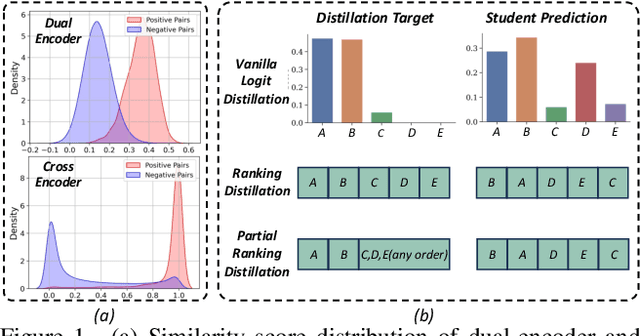
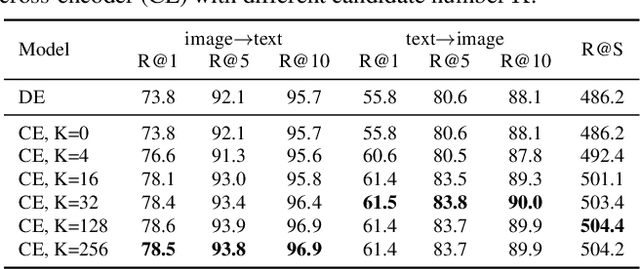
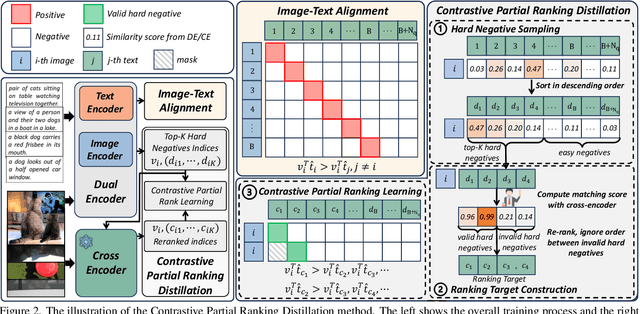
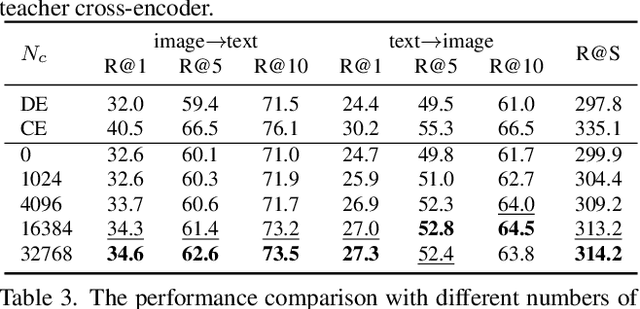
Abstract:Dominant dual-encoder models enable efficient image-text retrieval but suffer from limited accuracy while the cross-encoder models offer higher accuracy at the expense of efficiency. Distilling cross-modality matching knowledge from cross-encoder to dual-encoder provides a natural approach to harness their strengths. Thus we investigate the following valuable question: how to make cross-encoder a good teacher for dual-encoder? Our findings are threefold:(1) Cross-modal similarity score distribution of cross-encoder is more concentrated while the result of dual-encoder is nearly normal making vanilla logit distillation less effective. However ranking distillation remains practical as it is not affected by the score distribution.(2) Only the relative order between hard negatives conveys valid knowledge while the order information between easy negatives has little significance.(3) Maintaining the coordination between distillation loss and dual-encoder training loss is beneficial for knowledge transfer. Based on these findings we propose a novel Contrastive Partial Ranking Distillation (CPRD) method which implements the objective of mimicking relative order between hard negative samples with contrastive learning. This approach coordinates with the training of the dual-encoder effectively transferring valid knowledge from the cross-encoder to the dual-encoder. Extensive experiments on image-text retrieval and ranking tasks show that our method surpasses other distillation methods and significantly improves the accuracy of dual-encoder.
 Add to Chrome
Add to Chrome Add to Firefox
Add to Firefox Add to Edge
Add to Edge